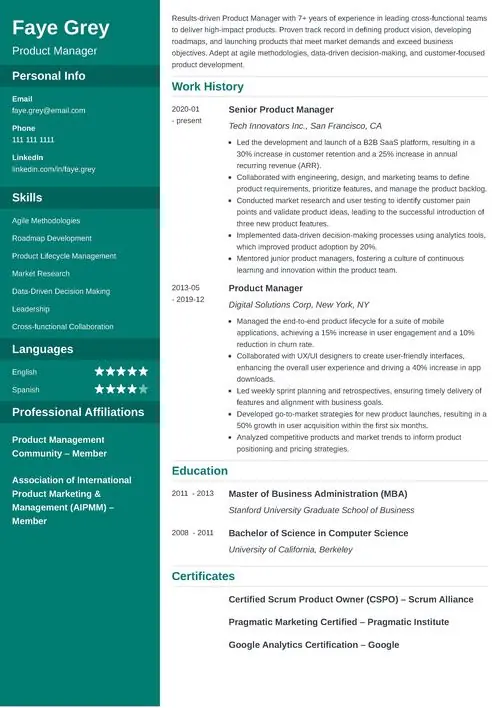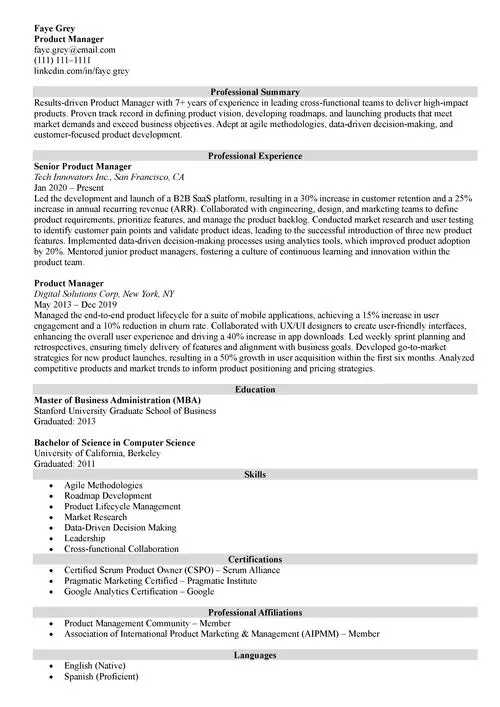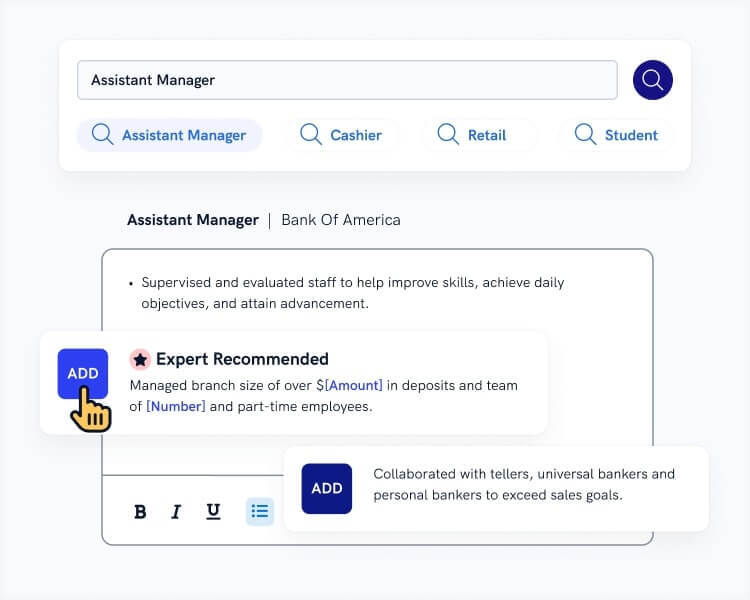You need specific product manager skills to convince your recruiter that you fit the job. Without a unique blend of skills, you won’t be able to navigate the complexities of developing and launching products successfully.
Demonstrate your ability to drive product innovation and success and win the heart of your future employer during the first iteration. Let's explore the critical skills every product manager should master to excel in this dynamic role.
This guide will show you:
- 15 key product manager skills for a resume.
- Easiest ways to learn product management skills.
- How to highlight your product manager skills on a resume.
Want to save time and have your resume ready in 5 minutes? Try our resume builder. It’s fast and easy to use. Plus, you’ll get ready-made content to add with one click. See 20+ resume templates and create your resume here.
Sample resume made with our builder—See more resume examples here.
One of our users, Brittanya, had this to say:
Zety really helped me create the best resume possible. It pointed out how things could be better on my existing resume and suggested many things to be re-worded or removed.
These guides might interest someone with product management skills:
- Product Manager Resume
- Product Marketing Manager Resume Sample
- Product Owner Resume Sample
- Project Manager Resume Sample
- Agile Project Manager Resume
- Manager Resume Sample
- IT Project Manager Resume Sample
- Program Manager Resume Sample
- Operations Manager Resume Sample
- Sample Resumes to Any Job
What Are Product Manager Skills?
Let's begin with a simple definition of product manager skills to understand better what we're dealing with today:
Product manager skills contain diverse abilities that help lead product development initiatives effectively. These skills combine technical expertise, business acumen, and leadership qualities to drive product strategy and execution.
Now, without further ado, let's list essential skills every product manager should cultivate to thrive in their role!
Pro Tip: Excellent product manager skills on a perfect resume might not be enough to land you the job you’re after. You should also write a professional product manager cover letter to boost your chances of getting invited for an interview.
15 Essential Product Manager Skills
The number of product manager jobs is increasing annually by around 30%. This produces significant growth opportunities in various industries, such as tech giants, financial institutions, and e-commerce companies.
However, you must prove you’re a skilled hire to get to those companies. So, let’s see what skills you should focus on in the first place.
Strategic Thinking
Strategic thinking allows you to develop and execute product roadmaps aligned with organizational goals. Product managers with strong strategic thinking skills can anticipate industry shifts and proactively position their products for market success.
Situations when strategic thinking can be used:
- Developing long-term product strategies.
- Identifying market gaps and opportunities.
- Aligning product roadmaps with business objectives.
Additional skills:
- Market research and analysis
- Competitive intelligence gathering
- Scenario planning
Market Analysis
Market analysis helps product managers assess market dynamics, customer needs, and competitive landscapes. Furthermore, it allows you to make data-driven decisions that resonate with target audiences and drive product adoption.
Situations when market analysis can be used:
- Conducting market research to identify customer pain points.
- Analyzing competitor products and strategies.
- Forecasting market demand and trends.
Additional skills:
- Customer segmentation
- User persona development
- SWOT analysis
Stakeholder Management
Building and maintaining relationships with cross-functional teams, executives, and external partners is impossible without solid stakeholder management skills. It helps you foster a collaborative work environment and drive consensus on product decisions.
Situations when stakeholder management can be used:
- Facilitating cross-functional meetings and workshops.
- Negotiating project timelines and resource allocation.
- Addressing stakeholder feedback and concerns.
Additional skills:
- Influencing without authority
- Conflict resolution
- Building strong relationships
Communication
Clear and effective communication is essential to convey vision, priorities, and progress to stakeholders at all levels. Product managers with strong communication skills can inspire cross-functional teams and rally support for product initiatives.
Situations when communication can be used:
- Presenting product roadmaps to executives and stakeholders.
- Facilitating sprint planning and review meetings.
- Writing clear and concise product requirements.
Additional skills:
- Presentation skills
- Active listening
- Technical writing
Leadership
Leadership skills inspire and motivate cross-functional teams to achieve product goals. It involves setting a clear vision, providing guidance and support, and empowering team members to deliver their best work.
Situations when leadership can be used:
- Setting product vision and strategy.
- Empowering team members to make autonomous decisions.
- Leading by example and fostering a culture of continuous improvement.
Additional skills:
- Team building
- Coaching and mentoring
- Decision-making
Product Strategy
Product strategy involves defining clear objectives, identifying target markets, and developing a roadmap to achieve product goals. With this skill, product managers can align their products with market needs and drive sustainable growth.
Situations when product strategy can be used:
- Defining product vision and goals.
- Prioritizing features based on market demand and business value.
- Adapting product roadmap in response to changing market conditions.
Additional skills:
- Strategic planning
- Risk management
- ROI analysis
Product Lifecycle Management
Product lifecycle management helps you ensure that products meet customer needs and remain competitive. It allows product managers to oversee the entire lifecycle of a product from ideation to retirement.
Situations when product lifecycle management can be used:
- Conducting market research to identify customer needs.
- Defining product features and requirements.
- Managing product launches and updates.
Additional skills:
- Cross-functional collaboration
- Agile development methodologies
- Continuous improvement
Data Analysis
Collecting and analyzing data to identify patterns, trends, and opportunities that inform product decisions is a massive part of your job. Data analysis helps you make informed decisions that drive product success and improve user experience.
Situations when data analysis can be used:
- Analyzing user feedback to prioritize product features.
- Monitoring key performance indicators (KPIs) to track product performance.
- Identifying trends and opportunities based on market data.
Additional skills:
- Statistical analysis
- Data visualization
- A/B testing
User Experience (UX) Design
You can create products that delight users and drive loyalty and retention if you have strong UX design skills. This skill helps you create intuitive, accessible, and enjoyable products. Having it means you clearly understand users’ needs and can please them with the results of your work.
Situations when UX design can be used:
- Conducting user research to identify pain points and preferences.
- Creating wireframes and prototypes to visualize product concepts.
- Collaborating with designers to implement user-centered design principles.
Additional skills:
- Usability testing
- Information Architecture
- Accessibility standards
Agile Methodologies
Using agile methodologies makes your workflow more flexible and adaptable to various circumstances. If you’re efficient in this way of working, you can easily foster collaboration, transparency, and responsiveness within teams, delivering products of the highest quality.
Situations when Agile methodologies can be used:
- Prioritizing backlog items for sprint planning.
- Facilitating daily stand-up meetings and sprint reviews.
- Adapting product roadmap based on feedback and market changes.
Additional skills:
- Scrum framework
- Kanban methodology
- Continuous delivery
Delegation
Delegation involves assigning tasks and responsibilities to team members based on their strengths and expertise while providing guidance and support as needed. Effective delegation empowers team members, fosters collaboration, and enhances overall productivity.
Situations when delegation can be used:
- Allocating project tasks to team members based on their skill sets, experience, and availability.
- Empowering team members to take ownership of specific project components and make decisions within their areas of responsibility.
- Delegating decision-making authority to relevant team members for efficient problem-solving and project execution.
Additional skills:
- Trust-building
- Performance management
- Conflict resolution
Critical Thinking
Critical thinking lets you analyze information, evaluate options, and make well-informed decisions. It involves asking insightful questions, challenging assumptions, and considering alternative perspectives for optimal solutions. All that to drive product strategy and innovation.
Situations when critical thinking can be used:
- Assessing market trends, customer needs, and competitive analysis to identify strategic opportunities and threats.
- Evaluating user feedback, data analytics, and performance metrics to prioritize product features and enhancements effectively.
- Identifying potential risks, constraints, and dependencies to develop contingency plans and mitigate project risks.
Additional skills:
- Problem-solving skills
- Data interpretation
- Scenario analysis
Product Roadmap Management
Product roadmap management involves creating and maintaining a strategic plan that outlines the vision, goals, and timeline for product development. It requires effective communication, collaboration, and prioritization skills to drive product innovation and market success.
Situations when product roadmap management can be used:
- Developing a comprehensive product roadmap that aligns with organizational goals, market demands, and customer needs.
- Communicating product priorities, milestones, and trade-offs to stakeholders to gain buy-in and support for strategic initiatives.
- Iterating and adjusting the product roadmap based on feedback, market changes, and evolving business needs to ensure relevance and effectiveness.
Additional skills:
- Stakeholder engagement
- Resource allocation
- Change management
Time Management
Time management enables product managers to allocate time and resources to prioritize tasks, meet deadlines, and optimize productivity. With this skill, you can plan, organize, and execute activities in a structured and efficient manner to maximize efficiency and minimize wasted effort.
Situations when time management can be used:
- Planning and scheduling product development activities, releases, and milestones to ensure timely delivery and stakeholder satisfaction.
- Balancing competing priorities, dependencies, and constraints to allocate resources, mitigate risks, and maintain project momentum.
- Implementing time-saving strategies, productivity tools, and automation solutions to streamline workflows, eliminate bottlenecks, and improve team efficiency.
Additional skills:
- Goal setting
- Decision-making under pressure
- Task prioritization
Flexibility
As a product manager, you must constantly adapt to changing circumstances, embrace new ideas, and adjust strategies. That’s how you respond to market dynamics, stakeholder feedback, and emerging opportunities or challenges. Flexibility is a must for a product manager.
Situations when flexibility can be used:
- Reprioritizing tasks and reallocating resources to meet new objectives.
- Adapting to iterative processes, accommodating changes based on user feedback and market trends.
- Pivoting strategies, seizing emerging opportunities, and addressing competitive threats.
Additional skills:
- Adaptability
- Versatility
- Open-mindedness
Find out what other skills to put on your resume that will make you look like a pro: Professional Resume Skills
Creating a resume with our builder is incredibly simple. Follow our step-by-step guide and use content from Certified Professional Resume Writers to have a resume ready in minutes.
When you’re done, Zety’s resume builder will score your resume and our resume checker will tell you exactly how to make it better.
How to Learn Product Manager Skills
Continuous learning is vital for any career. The same goes for you as a product manager. There are ways to develop the skills mentioned above and grow as a professional. Here are some effective methods to boost your product manager skills:
Seek Feedback and Iterate
Ask for peer, mentor, and stakeholder feedback on your product management efforts. Embrace constructive criticism as an opportunity for growth and continuous improvement. Use this feedback to identify development areas and refine your product management approach.
Participate in Workshops and Seminars
Attend workshops, webinars, and seminars conducted by product management experts. This will allow you to gain insights into emerging trends, best practices, and innovative techniques in product management.
Seek Mentorship
Connect with experienced product managers who can guide, advise, and mentor as you navigate your career path. Learning from their experiences and tapping into their expertise can develop your product management and learn some new project management skills.
You know the skills you need to show and how to enhance them. Now it’s time to figure out how to show them on your resume.
Want to learn some more skills? Choose wisely. Visit our guide: High-Income Skills for 2024
How to Include Product Manager Skills on a Resume
You must incorporate your skills to showcase your qualifications effectively and strategically when crafting your resume. Here's how to do it right:
- Incorporate your skills in various areas of your resume to highlight your expertise. While the skills section is the most obvious choice, don't overlook opportunities to showcase them in your work experience section, resume summary or resume objective, and additional resume sections.
- Use action verbs to demonstrate your proficiency. Action verbs like "analyzed," "visualized," or "extracted" emphasize your ability to take initiative and deliver results.
- Support your skills with specific examples or projects from your professional experience. These examples not only validate your proficiency but also provide context for how you've applied your skills in real-world scenarios.
- Quantify your impressive achievements using data to illustrate the results of your skills. Listed well, they will easily add credibility to your skillset.
- Avoid listing every single one you possess. Instead, focus on the most relevant and impactful skills that align with the job requirements. A concise list ensures clarity and readability for recruiters.
- Indicate your proficiency levels, if applicable, for each skill to provide recruiters with insights into your expertise. Whether you're a novice, intermediate, or expert, clearly outlining your skill levels helps recruiters assess your qualifications accurately.
- Read the job ad carefully to identify specific skills the employer seeks. Incorporate these keywords into your resume to optimize it for Applicant Tracking Systems (ATS) and increase your chances of passing the initial screening process.
- Limit your skill section to the most relevant and essential ones. A concise list demonstrates your ability to prioritize and showcases your decision-making skills.
By strategically incorporating your skills into your resume using these techniques, you'll effectively demonstrate your qualifications and stand out as a top candidate.
Want to learn more about including skills on a resume? Visit our guide: Skill Set Example
Key Takeaways
Time for a quick recap:
- Product manager skills are what help you lead product development effectively.
- These skills blend people skills, analysis, and technical knowledge.
- To become an even better product manager, seek feedback, mentorship, and workshops.
- Show your product manager skills on a resume effectively in different sections using action verbs.
About Zety’s Editorial Process
This article has been reviewed by our editorial team to make sure it follows Zety's editorial guidelines. We’re committed to sharing our expertise and giving you trustworthy career advice tailored to your needs. High-quality content is what brings over 40 million readers to our site every year. But we don't stop there. Our team conducts original research to understand the job market better, and we pride ourselves on being quoted by top universities and prime media outlets from around the world.



